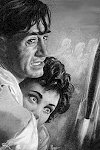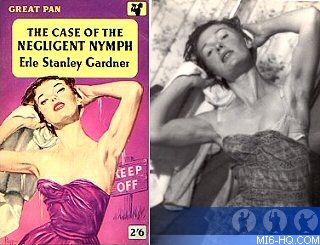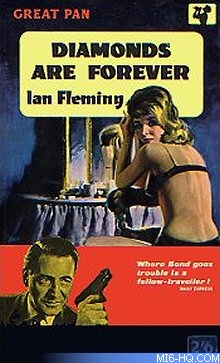 |
| |
Years before James Bond hit the silver screen, fans
of 007 saw their hero on the cover of Pan paperbacks
with cover art by Sam Peffer...
|
|
The Art Of Sam Peffer
21st October 2007
When Pan first started publishing the James Bond adventures
by Ian Fleming in paperback in the mid-1950s, the book covers
were painted in the style of American novels of the day. The
first, "Casino Royale", featured a youthful 007 modelled
after Richard Conte. Artist Josh Kirby, who later went on to
create cover for Terry Pratchett's "Discworld" series,
painted the first covers for "Moonraker", "Live
And Let Die" and "Diamonds
Are Forver" in successive
years from 1956.
Sam Peffer, who had just signed to Pan, was assigned the mission
of creating their James Bond covers from 1957 to 1962. Unlike
the previous Pan paperbacks, Peffer gave 007 a consistant look
throughout his series, basing the appearence of Bond on model
Dick Orme.
|
Above Left: 2nd to
6th edition (1959 to 1961)
Above Right: 7th to 11th edition (1961 to 1963)
|
"Peff", as he signed his covers, read each of the
novels to identify key scenes which would be appropriate for
an exciting cover. He was given free reign to decide on an initial
selection, which would then be roughed out for approval by the
Pan art editors. The key ingredients were the hero (Bond) and
heroine (Bond Girl) and something relevant to the plot - but
without giving it away.
One of the restrictions placed upon Peffer was not to depict
any blood or physical violence on the covers. Some of the initial
choices had to be replaced because with the violence removed,
the scenario no longer made sense.
|
Above: 1st to 3rd editions
(1960 to 1961)
Above Right: 4th to 14th editions (1961 to 1965)
|
It was around this time that fellow artist John
McLusky was
also in the process of giving a face to James Bond, this time
for the comic strip adaptation of "Casino
Royale" in
the Daily Express. A little over a year since Peffer created
his first Bond cover, McLusky's inital visualisation of the character
was quite different, but would develop some similarities over
later years.
Peffer owned many of the props seen in
his covers, but relied on Maurice Angel, Bermanns, and
Lathams to supply a lot of the theatrical costumes. He
used his own Army and Navy uniforms when required, but
never had one from the Airforce.
To assist his painting, Peffer hired models to pose for
the design he had in mind. Model fees at that time were
two guineas an hour, so Peffer often modelled himself or
his wife Kitty.
When it came to action scenes, Peffer drafted
in his brother-in-law, who was a top stuntman who stood
in for the likes of Robert Shaw and Errol Flynn. |
|

Above: Peffer's wife Kitty models
for the 1958 Pan paperback "The Case
of the Negligent Nymph" |
Some of the later re-issued covers featured Peff's original
artwork with a band along the bottom of the cover featuring a
small retouched photograph to represent James Bond. The face
was actually that of Ralph Vernon-Hunt, then director of Pan
Books. The early Pan covers also featured a 007 logo that was
also used on the UK quad posters for "Dr.
No" and "From Russia
With Love".
|
|
|
 Above: 5th edition (1961)
Above: 5th edition (1961)
Left: 10th edition (1963)
Notice the
error on the 10th edition where the yellow bar
has been pasted
over the original red bar from the 5th edition.
The top of Bond's head is still visible.
|
|
The end of Peffer's run coincided with Sean Connery launching
the film series with "Dr No" in
1962, when Pan opted for film tie-in covers. At the height of
Bondmania, the Pan paperback
editions shifted over one million copies each year between 1962
and 1967.
In the following decades, Glidrose (now Ian Fleming Publications)
set policy that dictated James Bond would not be seen on any
book jacket except the photographic covers for film tie-ins,
even including the latest
series of pulp-style covers by artist Richie Fahey. Sam Peffer's covers remain an iconic contribution
to the Bond canon, and are now highly collectible items.
Related Articles
 Sam
Peffer Biography
Sam
Peffer Biography
 James
Bond Literary Coverage
James
Bond Literary Coverage